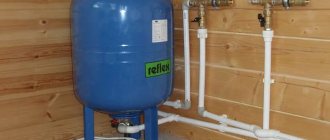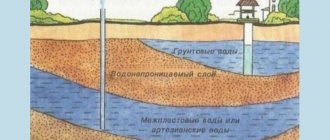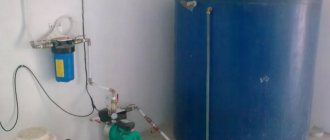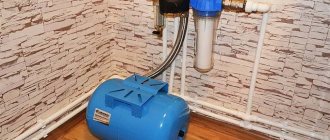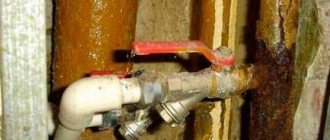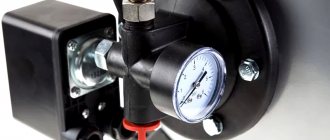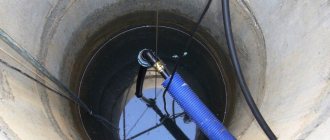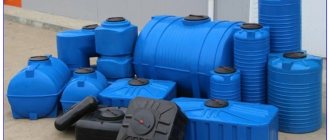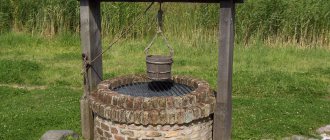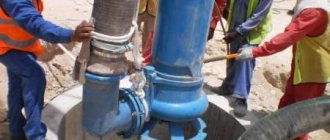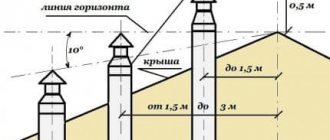- How to calculate pump power
- Internal sewerage
Sewage systems for a private home or summer cottage differ from urban ones in their autonomy. And while some country villages have central water supply, they do not have sewerage. Therefore, it is important to think through all the nuances of pipeline installation.
Sewerage and water supply system design
The system design includes the location of sewerage nodes and information for installers. This is necessary for convenient and correct reading of the project. Therefore, the symbols for sewerage according to GOST are alphanumeric.
The project includes:
- well table data;
- pipe layout plan for wastewater disposal;
- specification.
The drawing also shows the information necessary for installing the sewer system.
Future sewer plan
Only with a responsible approach to design will the systems work without breakdowns and will not create problems for residents. It will not be possible to complete such a task without knowledge and experience on your own, so it is better to entrust the work to a designer.
Autonomous navigation: bottlenecks of local sources
If the water supply is organized using local water resources, the project becomes more complicated. The bottleneck that limits the volume of water consumption may be a limited well (well), low sewerage capacity and the need to install water treatment systems.
In the first case, the problem will have to be solved by integrating additional storage tanks into the water supply system. The storage tank maintains the supply of water necessary for everyday needs (it is pumped from a well or well during periods of limited water use, for example at night), while the automation must prevent overflows and operation of the pump in dry running mode. But such containers are an extreme case. In the standard version, hydraulic accumulator tanks are located after the main line enters the house. They come in different sizes. The task of a small one (up to 24 l) is to create pressure, smooth out its differences, eliminate water hammer and extend the service life of pumping equipment. A capacity of 80–150 liters will allow you to have a certain supply of water in case of a sudden power outage: the user will have about a third of the above volume at his disposal to finish taking a shower or wash the dishes.
It also happens: there is a lot of water in the well, but there is a problem with wastewater disposal. In such a situation, the volume of the treatment plant is selected based on the number of residents. For example, one- or two-digit numbers in the names of “box” water treatment plants of different models usually indicate the estimated number of users. But if 1-2 people permanently live in a house, experts do not recommend installing a station designed for 8-12 people: with limited use, the microflora working on wastewater treatment will not have enough food.
The volume of a classic anaerobic septic tank should be equal to three times the daily consumption rate (a 1.5 m³ septic tank processes 500 liters of wastewater per day). But purchasing a more expensive and productive treatment plant does not always allow the restrictions to be lifted - after all, the wastewater after clarification is discharged onto the terrain. And if the absorption capacity of the soil is insufficient, then the wastewater has nowhere to go. The only solution is to limit consumption.
Finally, if the water quality is far from potable, bulky water treatment systems will be required. The main problem with water from wells is excessive mineralization, which is “treated” by selecting filter elements, backfills and reagents. Water from surface sources or wells often contains bacteriological contamination, and its quality may vary throughout the year. Filter systems are also used here, and in some cases additional ultraviolet disinfection is recommended. All this equipment requires not only space for placement, but also regular maintenance.
Symbols in the drawings
Before designing a residential building, nuances that may affect the operation of the plumbing system are determined. You need to find out in advance whether there is a centralized network near the construction of a residential building and whether pressure drops can occur due to it.
If there is no network, a local water supply system is created. In this case, a storage tank is installed.
Project stages:
- Calculation of the maximum load on the supply pipeline in the house (depends on the number of water intake points in the house and on the site).
- Selection of options for restoring water supply standards when pressure in networks decreases.
- Selecting a device according to a suitable scheme.
To accurately locate the water supply symbols on the drawing, it is necessary to establish what elements the system consists of. The price and quality of materials for fittings and plumbing fixtures can be anything. This does not affect the operation of the system in any way.
How to design water supply from a well
To create an autonomous water supply project, you need to have complete information about the correspondence of the flow rate of the source, the daily need for water at home, and pump performance.
Therefore, design begins with determining the depth of the aquifer, calculating the daily flow rate of the future water intake, minimum and peak water consumption.
Each device has its own water consumption rate
This is the initial data, after receiving which the optimal source location is selected.
At the same time, the location where the cesspool or septic tank will be built is determined, since the distance between the sewage tank and the drinking well (and other own and neighboring buildings and structures) is strictly regulated.
Sewerage markings K1, K2, K3
Each drawing indicates o and the number 1,2 or 3. The marking depends on the purpose of the sewerage system.
For a household system, “K1” is used, for a rainwater system – “K2”, for an industrial system – “K3”.
You cannot put symbols in the drawing that are not specified in the regulatory documents GOST 21.205-93 and SNiP 2.04.03-85 (SP 32.13330.2012). This is necessary so that workers can find the desired designation and correctly complete the work on the project.
The use of symbols according to the regulations allows you to achieve the normal functioning of the sewerage system for a long time. Owners of houses or apartments will not worry about problems in the utility network.
Design stage: find a location
We conclude: the smaller the production volume and the worse the water quality, the more space the additional equipment takes up. If, with a centralized water supply, the owner of a cottage can limit himself to a collector cabinet in the kitchen or bathroom, then in cases where a well or a well is used as a water intake, it is advisable to provide a separate room for the water treatment unit.
Be prepared for the fact that the main elements of a comfortable and uninterrupted water supply will consume from 2 to 4 square meters. m area. In finished projects, separate rooms are necessarily provided for the boiler room or boiler room, which allows engineering equipment to avoid taking up precious meters in the bathrooms and kitchen. Such a room must be ideally insulated, and it should contain not only pipes, valves and containers, but also electrical power elements of the control automation.
Storm drainage design
To design a stormwater system, you need to perform the following calculations:
- Select the type of drainage: self-draining or forced. In the first case, it is necessary to calculate the slope of the pipe for normal wastewater drainage and indicate the marking.
- Determine the location of sanitary facilities in the room and options for connecting them to the sewer system.
- Select the type of sewerage drainage: centralized or autonomous. The first involves the removal of waste through the village-wide sewerage system. In the second case, disposal is carried out through a cesspool.
Designing a water supply system in a private house
There are three approaches to developing a plan:
- Connect to the central water supply network.
- Organize water supply from a well.
- Organize water intake from a well.
In the first case, when designing, you need to obtain permission to connect to a water pipe. The local water utility must provide a connection point from which a water supply line will need to be installed to the house. It is in this place that a well is installed, into which a valve or valve is installed, a water flow control meter, and a coarse mesh filter in front of the water meter.
The basic rule for laying a water pipe to a house is to find the shortest path without bends. More recently, there was another requirement: the laying of the pipe network must be below the freezing level of the soil. Today it is not necessary to do this, because a water pipe can be insulated, and the modern building materials market offers a huge variety of different types of insulation.
Since the pipe is inserted either through the foundation or through the wall of the house, therefore in these structures of a private house it is necessary to provide a through opening, which is formed, for example, by a polymer pipe.
Regulatory acts
SP 32.13330.2012 specifies the requirements for calculations, pumps, manholes, air duct stations, and sewers.
In addition, general positions, laying depth, design speeds, connections, laying slope, turns, fillings and minimum pipe sizes are taken into account.
The rules contain links to regulatory documents that are necessary for the design of a water supply and sewerage system.
The rules include the technological section, dispatching, standards for electrical appliances, space-planning solutions, automation system, technology control, control system, standards for sewerage in special climatic conditions.
Expensive pleasure
Home water supply systems are one of the most voracious and unpredictable energy consumers. The project section “Power supply” in relation to engineering plumbing requires particularly pedantic calculations, because sometimes the actions of the automation elements that control the heating and pumping of water may go beyond the specified scenarios.
For example, when you open a faucet or press the toilet flush button, the lights in the house go out. It would seem, what is the connection? Straight. Let’s assume that the water heater and “warm floor” are turned on in the bathroom, and the activation of the pressure switch, which turns on the pump in the well, becomes the last straw, increasing the load to the value at which the fuse trips.
And what about protection from a fool running out of the shower to see what clicked in the shield? To supply power to pumping systems, it is necessary to provide a separate line with its own fuse box, dry-running protection and an additional residual current device (RCD). At the same time, power electrical equipment should not be located in areas of high humidity in bathrooms.
Another problem is noisy pumping equipment. Even if the well is located next to the cottage, it is not advisable to place a pumping station in the house. For home plumbing with water supply from a well or borehole, systems with submersible pumps are preferable.
Utility networks during topography
The main task of surveyors when conducting a survey is to determine the location and plotting of internal and external utility networks and linear elements on a topographic map.
The object of search work and topographic surveys can be underground or above-ground communications. If it is necessary to update the plan taking into account the terrain or draw up new documentation, you need to study materials from the archive and the existing geology of the site.
When conducting topographic surveys, it is important to agree on the nuances and obtain permits indicating diagrams, technical data, designed plans of linear structures, and route profiles.
Then data is collected using a tacheometer and a GPS device and desk processing of the information is performed. On the topographic plan, the necessary relief features, sewerage and water supply elements are noted.
The most modern methods of water purification
The latest methods are gaining increasing popularity, capable of providing filtered liquid in large volumes for household and drinking needs without special operating costs. Of these, it is worth noting:
- Air aeration. There is pressure and non-pressure. This method is based on oxygen enrichment, due to which manganese and iron sink to the bottom.
- Electrochemical aeration. A budget-friendly, compact and virtually silent method of cleaning. Based on electrochemical reactions with the release of ozone and oxygen. Effective for purifying liquids rich in iron.
- Ion exchange filters . An ion exchange resin in several reservoirs, when water passes through it, retains calcium and magnesium ions and allows sodium ions to pass through, which allows salts to be separated from the liquid and softened. Over time, the amount of sodium in the resin decreases and requires restoration - this is the main disadvantage of this cleaning method.
Manufacturers
There are many companies on the market that are developing cleaning methods. Among them are:
- "Ecodar";
- “Voder” - comprehensive cleaning;
- drinking: “Atoll”, “GE Merlin”, “Aquafilter”;
- ultraviolet sterilizers “Lazur”, “Steriling”, “UDV”, “Blex”;
- mechanical filters “Honeywell”, “AZUD” and many others.
Main stages of water supply installation
The work necessarily includes the following steps:
- Clarification of the task and agreement with the customer.
- Marking and positioning on site.
- Formation of technological holes, niches.
- Excavation work (digging a trench, creating a cushion, laying thermal insulation).
- Rough line laying.
- The final connection.
- Pressure testing (pressure test).
- Fixing the pipe to the wall of the building.
- Test activation (flushing).
- Decorative finishing.
Video description
Comparison of wells and wells on video:
Types of wells
There are two main ways to organize water supply for a private house from a well - the scheme may involve the use of an artesian well (up to 150 m deep) or a so-called “sand well” (15-50 m). They differ not only in depth, but also in service life. The former can be used for up to 50 years, and the service life of the latter is usually 8-20 years.
Artesian wells are drilled using special equipment. Each such well is registered and a passport is issued for it. As a result, this work can only be entrusted to professionals.
Drilling wells “into sand” can also be done manually, using an auger drill and extending its handles with pipes of suitable diameter.
Selection of pumping equipment
Pumping equipment is used to supply water to points of consumption from the source. These can be individual pumps of various types (most often submersible - centrifugal or rotary) or pumping stations. When choosing such equipment, the following parameters and technical characteristics must be taken into account:
- Water consumption;
- Minimum water supply column;
- Highest point of water consumption;
- Well depth;
- Nominal pressure (indicated in the passport);
- Productivity (m³/hour).
In addition to the passport, all characteristics of the pump are indicated on the tags. Source kolodec-mos.ru
The most popular and widespread are submersible pumps, the pressure of which is 60-80 m, and the productivity reaches 4 m³ per hour.
Advice! It is recommended to connect pumping equipment through a voltage stabilizer. This is especially true for small settlements where there are periodic power outages or voltage surges.
Which autonomous system to choose - with a well or a borehole?
A well is constructed when the water in it is suitable for drinking. This is obtained from a depth in the soil from 4 to 15 m.
When deciding to operate a well, it is very important to consider whether it can supply water to a family of four.
The average well stock is 200 liters. The disadvantage of water intake from a well is the high probability of groundwater getting into drinking water.
Another option to connect water is to drill and equip a well.
Whether it is better than the option with a well depends, first of all, on the characteristics of the soil in the local area. Another important factor is the depth of the aquifers and their productivity.
When thinking about what kind of water supply project to implement in a private house, in a number of cases they decide to take advantage of the benefits of a well water supply system:
- water flows into the home in any case, even if the equipment fails - you can collect water in containers or buckets suitable for it;
- service life - an equipped well is used for at least 50 years;
- affordable cost of construction, which in the case of a well is much more expensive.
As you can see, the decisive factor when choosing a water supply source is the size of the budget for water supply facilities.
The price of a well is influenced by: drilling method, type of structure, the possibility or impossibility of using productive equipment during drilling and other factors.
As a rule, a well is drilled using special equipment, and the trenches for the pipes are dug by the site owners or contractor employees.
Before you finally decide whether to choose a well or a well for country water supply, talk to your neighbors and local residents.
Try the waters of those who live nearby. If most of the homeowners in the area use a well, it is probably locally feasible, economical, and reasonably effective.
If you decide to build a well, you should know some drilling features. There are two types of wells - artesian or “limestone” and “sand”. The choice of design for arrangement is determined by the depth of the aquifer and its type.
Drilling a well “on sand” - features
When drilling a well “into sand”, they use the upper layers of the “sandy aquifer”, which lies under the loam that filters groundwater.
Such a well often goes 40-50 m deep. If during drilling they fall into the bed of an underground river, then it is enough to make the well no more than 15 m deep. In this case, the filters and pipes of the system do not become clogged with sand, since the soil layer has a pebble structure, and excavation is reduced.
The facility can be operated for 15 to 20 years. A standard well lasts 5-7 years. If we talk about a 15-meter depth, then it is easier to achieve it manually. With this kind of drilling - experimentally - the probability of hitting a good water carrier is higher.
The operation of special equipment is associated with serious costs, and this method of drilling, according to many experts, is less effective. After all, the machine drills only to a given depth, and getting into a good water carrier is more problematic.
Drilling a well “on limestone” - features
An artesian well is drilled to limestone rocks, which can lie at a depth of 130-140 m.
Artesian water obtained from a well is of better quality, and its supply is practically unlimited. Minimum – 1500 l.
There is no need to install special equipment for water intake, since the water enters under high pressure.
Under pressure, it breaks out to the surface of the well itself. The source can be operated for 50 years.
Among the disadvantages of a well as a key component of the water supply system of a country house, its high cost and the need for registration should be mentioned. Since the limestone aquifer is included in the state strategic reserve, the object must be registered.
Equipment and its cost
A water supply project for a private home involves the operation of special equipment that is installed in the living area and above the source.
Raw materials are supplied using household water supply stations. Thanks to them, the supply and pressure of water is uninterrupted. The pump is connected to a hydraulic accumulator, to which drainage systems are connected.
When the water in the house is turned on, when residents open the faucet in the kitchen or bathroom, the water pressure in the system decreases. The control relay is usually activated when a value of 2.2 bar is reached, turning on the pump, which begins to pump water again.
Water continues to flow into the system until the pressure reaches 3 bar. In this case, the relay is activated again and the pump is turned off.
When a pump is installed above the source, a caisson is used in which the well is connected to the water supply system.
- The price of the caisson is approximately 15 thousand rubles.
- The cost of the pump depends on its technical characteristics. On average it is 2-4 thousand rubles. It is not recommended to buy a pump in advance.
After all, the technical parameters of the source are precisely determined only after drilling, and it is better to purchase pumping equipment that meets them. This will allow you to choose the optimal type of product that can supply water uninterruptedly.
General scheme of water supply in a private house
Required elements of the system:
- Water source.
- A hydraulic accumulator that generates the required pressure and controls the operation of the pump.
- Water filters – purifying and preparing water. To choose the right equipment, you need to conduct an examination by sending a water sample for laboratory testing. Process water is supplied to the house separately. Since this water is not prepared from it and is not drunk, it does not need filtration.
- The pump forces soil water into the system.
- A water heater is used to provide hot water to a home.
Features of well arrangement
- The time is right . It is better to carry out installation work in the summer, at the end of spring or beginning of autumn, when it is warm outside and it is easier to identify a good water carrier in the ground.
In the warm season, the water does not rise, the soil is more pliable, and digging trenches is easier. Due to the fact that the hydraulic accumulator is very expensive, many homeowners do without it, replacing the device with homemade analogues for regulating the pump.
- Place for a water source. Quite often people decide to dig wells for home water supply. It is easier and cheaper to equip such a facility.
And as already mentioned, in case of unforeseen circumstances, water intake from the well is possible using buckets. But before digging begins, you should decide on the choice of location for the water intake point.
They search for something suitable for a well using proven folk methods, or with the help of modern devices.
The surest way is to visually observe the volume of dew and its presence at 4-5 am for six months. Based on a summary of such observations and a diagram, you can find out exactly where more moisture accumulates. It is in this place that the well should be built.
When choosing a water intake point, sanitary restrictions must also be taken into account. At a distance of 50 m from the well there should be no compost heaps, cesspools, sewage drains, toilets or other pollution.
It is better to dig a hole at some distance from the house so that the washing out of sand from the soil does not cause the foundation to move.
Having determined a place for a well shaft, you can order a water supply and sewerage project for a private house. It is better to contact an experienced contractor who has sufficient knowledge and skills.
Although design is relatively expensive - a project can cost 50 rubles per square meter of plan - it requires a professional approach.
Only specialists can give accurate guidelines in the arrangement of water supply, select equipment correctly, calculate estimates and design an up-to-date and complete system that can work efficiently for many years.
In the meantime, while the contractor is preparing a project for the external water supply of a private house, in the case of a well, you can start digging it.
- Construction of a well pit. A well shaft with reinforced concrete rings is one of the most common options for arranging water sources. For its construction, the corresponding site is first leveled.
Then a circle is drawn with a radius greater than that of the concrete ring by 10-20 cm. Digging a hole is carried out using a shovel. You should stop when the edge of the ring placed in the hole protrudes 10 cm from it.
Typically, the side of the element rises to a height of 0.9 m, and sometimes 1 m. Once the required depth is reached, the reinforced concrete ring is immersed in the pit. In this case, at least 3 connecting brackets are installed on the end part.
They continue to dig the hole until the depth again reaches the height of the ring. The soil placed in the container is lifted up. Having reached the desired depth, the first ring is lowered, fixing the second ring to its end with staples.
In the latter, a hole is made with a diameter 1.5 times greater than the diameter of the pipe used in the water supply system. The work continues until water begins to seep into the well shaft.
As a rule, water intensively flows into the well on a 6-8 concrete ring. It is better if there are at least 3 fontanelles. Having stopped digging and laying the rings, the sand and water are pumped out, and the soil is removed.
Then they go deeper another half a meter, keeping the pump on, as the water flows intensively. Having completed the excavation, the mine is left for a day to determine the water level. It is covered and fenced to avoid accidents.
- Completion of the well arrangement . After a day, the water level is checked, controlling the mark of 1-1.5 m. This value is optimal. The water is pumped out, small stones are placed at the bottom of the pit, then a layer of crushed stone 30-50 cm high. This creates a natural water filter. Each joint of the rings is sealed with a mortar of cement and sand. If the work is carried out correctly, the well shaft is filled with water to 1.5 rings.
- How is the connection made?. The arrangement of water supply involves the installation of equipment and drainage systems. A trench is dug from the water source to the building, passing below the depth at which the soil freezes.
A pipe made of any suitable material is placed in the trench. When choosing pipes, they are guided by the budget and the characteristics that need to be obtained from the water supply. A common choice is metal-plastic pipes, which are easy to install, quite flexible, durable and strong. Experts advise installing the pump in the utility room of the house.
- Branch laying . You need to insert the pipe leading from the well into the hole on the concrete ring, bend it and lower it to the water in the shaft. A mesh filter must be placed inside the outlet. Make sure that the bottom of the pipe rises from the bottom of the well shaft by 30-40 cm.
Having reached this mark, the water is pumped out again, then a pin is driven into the well bottom. The pipe is attached to a pin. In a reinforced concrete ring, the hole is covered with a cement solution, after which the trench is buried.
At a depth of 0.4 m and at a distance of 1.5 m from the concrete rings, a clay castle is built near a water source. Its standard thickness is half a meter. A clay castle allows you to protect the well from rain and groundwater entering the source.
- Equipment Tips . The water supply installation is selected based on the technical parameters of the well. The most popular units raise water to a height of 40 m and pump from a depth of about 9 m. If the source is remote from the house, it is better to buy a self-priming centrifugal pump with an external injector. This one pumps water from a depth of 45 m.
- Pump installation. In the place where the pumping station is supposed to be installed, a minimum winter temperature of 2 degrees is permissible. Before entering the pump, you need to install a check valve and install a coarse water filter. A fine filter is placed behind the unit.
Then a pressure gauge is connected to the equipment, which reacts to the pressure of a relay and other devices. A pipe is inserted into the collector, which distributes water to consumers. The final work involves laying the wiring inside the house - room by room.
Features of well construction
When choosing a water source, in this case the same restrictions as outlined above are taken into account. The main difference is that the well can be installed directly next to the house.
The cost of a water supply project for a private home is higher in this case. Drilling a well will cost approximately 2-3 thousand rubles per square meter.
The amount of payment is influenced by the remoteness of the site, the types of elements, pipes, equipment used, the presence of quicksand in the ground and other factors. To save money, some drill a well on their own.
- Self-drilling of a well . To drill a well, you will need a tripod, a core and a lift. The tripod is mounted above the intended water intake location.
First, a 1-1.5 m deepening is made using a pin drill, removing the outer soil layer. A casing pipe with teeth is placed into the resulting hole. A well is drilled for her until a good water carrier appears. Everything that penetrates it first can be passed through.
Having found a suitable layer, a zinc-coated water pipe with a filter installed at its end is placed in the casing pipe. The segments of elements are connected using a coupling, and the joint areas are well coated with sealant. Next, the casing pipe is removed.
- Installation of equipment . There are two installation methods - with equipment above a warm utility well or with the installation of a caisson. The second method is quite popular.
In this case, dig the pipe at a depth of 2.5 m so that the diameter is twice the diameter of the caisson. A concrete cushion is poured onto the bottom so that its thickness is at least 0.2 m. Such a cushion bears the load from the caisson.
The borehole pipe is cut so that it protrudes into the caisson by 0.5 m. At a depth of about 2 m, a trench is dug into which the water pipe is placed. Water will be transported through it to the home. A hydraulic accumulator is installed inside a warm room.
The pump is fixed inside the caisson, then connected to the drainage system. After installing the control unit and filters, the caisson is poured around the perimeter with a concrete solution approximately 0.4 m thick. When the concrete hardens, the remaining space is filled with a mixture of cement and sand, leaving approximately 0.5 m to the top, after which the soil is laid. All this provides high-quality protection for the caisson in case of frost.
- Distribution of water inside the building. When water is brought into the house, it becomes possible to distribute it indoors. An important stage of work is the installation of water heating equipment. The choice of devices of this type today is wide.
A good option might be a 2-circuit gas boiler. One outlet is used to heat water in the heating system, the second - for household needs. Cold water is supplied from the pump to the boiler. There is an outlet from the boiler with hot water connected to the collector.
The collector distributes the water resource throughout the building. The boiler can also be single-circuit. This is how water is heated only for domestic needs. Electric or gas boilers are used.
A storage water heater powered by electricity is often installed. Cottages sometimes have more than one instantaneous heater installed. After installing a water supply system in a private house, you need to arrange sewerage and drainage.
Conclusions:
When installing a pipeline, it is better to use the services or consultations of specialists; calculating the necessary parameters yourself can be a difficult task, as well as choosing the optimal filter.
The most popular systems today are reagent treatment, which operate through oxidative reactions with pollutants, but require constant maintenance to remain effective. Reagent-free - considered modern, but quite expensive, as they require an air compressor.
A well-thought-out organization of water supply will serve more than one generation of residents of a country house and provide high-quality water, directly affecting the health of the entire family.
Did you find this article helpful? Please share it on social networks: Don't forget to bookmark the Nedvio website. We talk about construction, renovation, and country real estate in an interesting, useful and understandable way.
Construction should begin with drawing up a drawing
For the most part, modern buildings are equipped with systems that are responsible for meeting sanitary standards. As a rule, this is a whole complex of engineering communications, which includes a hot and cold water supply system, sewerage, gas supply, garbage chute, drains, and heating.
This is necessary for people to live comfortably in a residential building. But in order for all systems to work correctly, the risks of problems must be minimized. And so that in case of any breakdowns the problem can be immediately eliminated, everything is carefully planned. The most important systems, including sewerage and water supply, must be thought out with the highest possible quality, drawn up, and then executed in accordance with a pre-drawn plan. Only if the drawing is drawn up correctly and all its requirements are met, it is possible to build a building that will meet all standards of livability and comfort.
